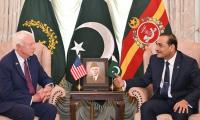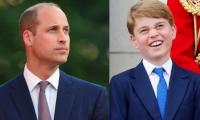How is the PPP taking the latest defections within its ranks? Just as a matter of course. The party’s chairperson, Bilawal Bhutto Zardari, has shrugged off the defections. He has stated that a few “uncles” had parted ways with his mother in the 1980s. Therefore, if some of them are also leaving him, it doesn’t really matter.
It is evident that the analogy drawn by the young PPP chairman between the defections that took place within the party when Benazir Bhutto was at the helm and those that are taking place now is not valid. During the 1980s, the PPP was the largest and most popular party in the country and had a nationwide appeal. So pervasive was the impact of the legacy of the late prime minister Z A Bhutto on the popular imagination that the nation’s vote bank was divided among those who either supported or were against Bhutto.
By the same token, the PPP’s strength was so enormous and Benazir’s appeal so charismatic – she was miles ahead of other political leaders of the day – that the establishment had to cobble together a political alliance, the Islamic Jamhoori Ittehad, to face up to the PPP in the 1988 elections. Earlier, her return to the country in 1986 had brought a cold sweat to the military regime. But such manoeuvrings failed to forestall Benazir from leading her party to victory.
The 2013 elections reduced the PPP from a party with a nationwide appeal to a regional outfit. The party was routed in Punjab and Khyber Pakhtunkhwa (KP). Had it not been for the voters in rural Sindh, the PPP would have been virtually wiped out from the political scene. Four years down the road, the PPP remains a shadow of its past. It is still trying to sell its ‘sacrifices’ for democracy and preach quietism as the supreme political virtue.
The party’s all-Pakistan character has crumbled. In Punjab, the largest province and the epicentre of political activity – where political battles are won and lost and where political fortunes rise and fall – the party is on the verge of extinction. Not surprisingly, the province accounts for the bulk of recent defections from the PPP to other parties.
In KP as well the party has shed a lot of its strength and it is only in Sindh that the PPP remains a force to reckon with. This has more to do with the identity politics practised by the party in Sindh rather than the spectacular performance of its government.
Unlike in the past, there is no charismatic leader at the helm in the PPP at the moment. Efforts to prop up Bilawal as the heir to Bhutto’s legacy have not borne fruit. The young man makes fiery speeches for a while and then goes into hibernation. The effective control of the party remains in the hands of his father Asif Zardari, a cold-blooded politician, who has a peculiar style of politics that is felicitous for wheeling and dealing but least suited to put life back into a dying organisation.
While the PPP is facing a leadership crisis, it has to contend with two rivals. Both parties have a strong leadership at the top. On the one hand, the PPP has to reckon with the PML-N – which is led by the House of Sharif, Pakistan’s most powerful political dynasty – while, on the other, it has to contend with the PTI – which has a highly popular Imran Khan at the helm. Much to the dismay of diehard PPP activists and supporters, it is Khan – and not Bilawal or Zardari – who has gone all-out against the ruling family in the Panama leaks affair.
If Prime Minister Nawaz Sharif is disqualified, the principal beneficiary will be the PTI and not the PPP. Even if Sharif is let off the hook, the major contestants in the 2018 elections will be the PML-N and the PTI, while the PPP will be nowhere. Sensing which way the wind is blowing, PPP leaders are moving towards greener pastures – which all politicians are entitled to do. Denuded of an ideological garb, all politics is power politics. In democracy, power is secured through elections. So why contest elections from the platform of a party whose popularity has nosedived?
The PPP’s erstwhile strength was popular politics. Z A Bhutto spearheaded the party towards victory in the 1970 elections in the then West Pakistan as the head of a popular movement against General Ayub Khan. It was he who introduced popular politics in Pakistan. ‘Roti, kapra aur makan’ was the watchword that fired the popular imagination.
Under his daughter Benazir, the PPP underwent three cardinal changes. First, the economic philosophy of socialism was discarded in favour of the market economy. Second, the PPP shunned its anti-Americanism. Benazir – either of her own accord or under duress – continued with the pro-Washington policies of her predecessor, the late General Ziaul Haq. Third, the party toned down its anti-establishment posture and, towards the end of Benazir’s life, it had become largely a pro-establishment party. However, the party did not abandon popular politics as doing so would have been disastrous.
Benazir’s spouse, Asif Zardari, presided over a fundamental shift in the party’s stance from populism to the politics of reconciliation. Zardari must have cogent reasons for the strategic shift and the changed stance may have enabled the PPP government to complete its five-year term (2008-2013) – the first democratically-elected government in Pakistan to do so. However, abandoning popular politics has almost written the party off. It is no longer seen to be the party of the people. Its vote bank has eroded, with one part going to the PML-N and another to the PTI. In every by-election in the Punjab over the past four years, the party has ended up as a distant third behind these two parties.
To top it all, the PPP’s diehard workers (jiyalas) – the party’s most valuable asset – are now largely a disillusioned and a rapidly alienated lot. Political activists constitute a vital link between the leadership and the people. This link is severed – as in the case of the PPP – when the activists lose faith in the party’s high command.
The head-in-the-sand approach of the PPP leadership offers no promise of the party’s revival. It seems they have reconciled themselves to the party’s rot in the Punjab and are content with maintaining their paramount position in rural Sindh.
In a multiethnic state like Pakistan, political parties are the ultimate instruments of political stability. Such polities need parties which have an across-the-country base and a nationwide appeal that can weld together various ethnic groups. In India, the Nehru dynasty-led Congress Party assiduously played this role. Meanwhile in Pakistan, the PPP has, over last four decades, been a symbol of federal unity. One may find fault with the PPP on several counts, such as bad governance and economic mismanagement. Yet, it would be unfair to brush aside the party’s contribution to keep the federation intact.
But now the PPP is itself a sinking ship and there is no other political party with a comparable all-Pakistan character and appeal. This has battened down the hatches for the PPP as well as the federation.
The writer is a freelance
countributor.
Email: hussainhzaidi@gmail.com
Sialkot’s products meet stringent international quality standards, ensuring reliability and safety in medical...
Once country with over 20,000 polio cases annually, Pakistan has made historic progress in curbing disease
In crowd of rightest and centrist politicians, Babar stands out as left-leaning activist and public intellectual
Tributes have flowed from highest in land to ordinary if you were to encounter them on street
On April 2, India tabled bill in Lok Sabha, proposing sweeping changes to management of Waqf properties
Trump had even imposed tariffs on uninhabited Heard and McDonald Islands near Antarctica







